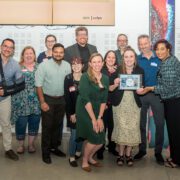Breaking the rules of the game is the new world order. By competing in novel and imaginative ways, organizations send a signal to the marketplace that breaking rules reflects the new normal; these disruptive organizations can usually catch their competition – regardless of size – off guard to the changing nature of the game.
And when – it’s always a matter of “when,” not “if” – disruptors dismantle the status quo, don’t expect advance warning. That’s because rule-breakers don’t seek permission or forgiveness. Perhaps they’re operating in stealth mode, or more likely, performing in plain sight. Whatever their degree of visibility, rule-breakers are busy and focused, committed to establishing a new process, selling a novel product or delivering a unique service. So, you’ll have to excuse them if they omitted the pleasantries of requesting permission.
As technology continues to flatten the world, it is not just enough to excel at the way the game was played. To compete, organizations are required to upgrade their performance, along with having the willingness and ability to play at a higher level for a longer period of time against all competitors – large and small, established and upstart.
That means in order to survive, let alone thrive in today’s hyper-competitive economy, organizations are challenged to strategically create their innovation playbook. This is why rule-breaking disruptors use strategic innovation as their modus operandi. How can innovation-oriented organizations systematically break the rules? By answering these questions:
- Who are our customers and what quantifiable benefits (e.g., profits) do they mean to our organization?
- What products and/or services should we sell to our customers? (I hope your organization’s answer is, “Because our products and/or services solve our customers’ problems.”)
- How do we deliver in a cost-effective and productive way?
Your organization’s answers most often reflect its philosophy of business. A video created by global thought leader John Spence adroitly addresses the philosophy of business. In summary, John maintains that a philosophy of business must align with the leadership’s direction and be in-sync with the organization’s culture. In addition, emphasis must reinforce how an organization’s philosophy of business supports its strategy and simultaneously holds team members accountable for their responsibilities and actions.
Disciplined execution of strategic innovation principles help to strengthen and clarify an organization’s philosophy of business. For starters, disciplined execution is an effective and proven strategy; second, strategic innovation benefits from being implemented in a disciplined fashion. Because strategic innovation doesn’t occur overnight and is not by its nature serendipitous, including discipline in the process goes a long way to producing successful outcomes.
What is so valuable about strategic innovation is what it identifies: “Gaps” in the marketplace. These gaps – the term “white spaces” is often used – reflect new, emerging customer segments or existing customer segments inadequately served by companies. Often, it is poor customer service or a company’s failure to develop a tighter relationship with customers that allow these segment gaps to form and for competitors – usually in the form of disruptive, status-quo busting game-changers – to enter the market.
Gaps appear for a number of reasons, many of which are layered and nuanced. Advances in technology, updated tastes and preferences, changes in government regulations or policies and other factors can produce gaps. Similarly, companies’ actions or inactions create gaps in the market.
I was reminded of this reality when reading a back issue of the MIT Sloan Management Review. The article, “Strategic Innovation” from the April 1997 issue, described how companies exploited gaps in the market and created transformative outcomes. Some examples of strategic innovation from the article:
- Howard Schultz bought Starbucks Coffee in 1987. It took Shultz five years of grinding (pun intended) to transform the company from a local/regional coffee chain into a worldwide phenomenon.
- In the late 1980s, Yamaha revitalized its declining piano business by introducing digital technology. Music lovers responded by either recording live performances by pianists or by purchasing – no downloads yet! – recordings they would then play on their pianos. The new technology was a blockbuster and piano sales in Japan exploded.
- In 1976, Apple introduced the Apple II in direct competition against entrenched leaders in the corporate, small business and home computing segments. And yet, within five years, Apple had become the market leader due to its innovative technology and company culture. As is well known, this occurred well before Steve Jobs was unceremoniously fired and returned to resurrect and immortalize the company and himself.
Without seeking permission, these rule-breaking organizations exploited “gaps” to disrupt their industries and change the world simultaneously. This lesson reminds us that leading organizations do not rise to the top because they play the game better everyone else does. Instead, world-changing organizations rise to the top because they change the rules of the game, all the while playing better than the competition.
So, when it comes to breaking the rules and disrupting the status quo, don’t seek permission. Ask for forgiveness.
***************
David Whitney writes about innovation and entrepreneurship and consults with companies on all-things involving innovation and entrepreneurship. Whitney has taught courses on innovation and entrepreneurship in both college and corporate classrooms and currently serves as Innovator- in-Residence at LeadingAgile Innovation Labs. As Innovator-in-Residence, Whitney uses his operational and subject matter expertise to help LeadingAgile’s clients and strategic partners deploy teams of entrepreneurial-minded employees to produce problem-solving, innovative solutions. In addition to these activities, Whitney serves as co-Chair of Innovation Gainesville 2.0, a regional-based initiative in which people and organizations collaborate to strengthen Gainesville’s innovation economy by bringing 3,500 jobs and securing $250 million in capital investment to the Gainesville region.

